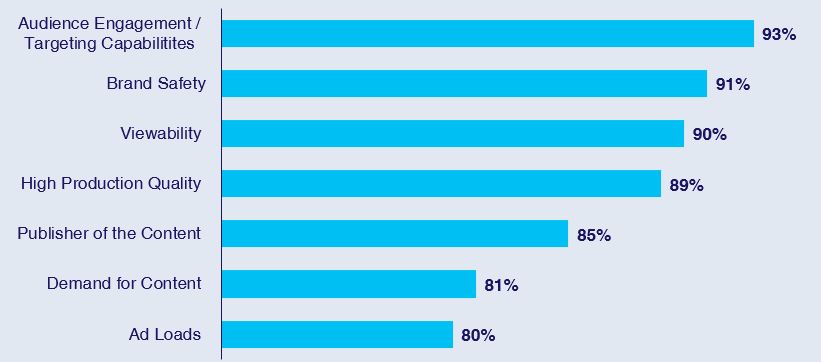Taking an agile approach to precision targeting and audience engagement using solutions such as audience-based TV buying, interactive and shoppable ads, and generative artificial intelligence allows marketers to quickly adapt to new technologies and gain a competitive advantage.
Brands today have a range of innovative formats, technologies, and applications for multi-screen TV advertising. Marketers who want to engage consumers and inspire them to take action should continually research, test, and integrate these new formats into their strategies. A proactive approach will help them keep up with the current market while anticipating future changes and maintaining their industry leadership.
Five key drivers of innovation and creativity in ad-supported media
According to a survey of 3,400 agencies in 2023 (The Myers Report), the top drivers of innovation and creativity in ad-supported media include offering customisable targeting (68%), offering creative partnerships or sponsorships (52%), offering innovative analytics and measurement options (50%), offering innovative ad units (50%), and investing in innovative technology options (37%).
When it comes to reaching the right audience, the number one priority for 61% of marketers, targeting and engagement opportunities are the most important factors for campaigns (93%). Brand safety, brand viewability, and high production quality ranked next.

Marketers are using a range of innovative solutions to enrich their engagement among their primary potential customers:
- Audience-based TV buying;
- Interactive and shoppable TV ads; and
- Generative artificial intelligence.
Audience-based TV buying
This strategy refers to audience segmentation beyond traditional demographics, targeting a group of consumers based on behavioural, attitudinal, lifestyle and/or transactional data. 39% say it is a key part of their TV buying strategy. This is because it enables the brand to achieve better results during the purchase journey.
According to VAB’s Audience-Based Buying Survey (2023), 74% of marketers believe audience-based TV buying can influence brand awareness, 72% think it can increase the effectiveness of the overall media plan, and 71% are confident that it can expand the reach of their target audience. Other benefits of this strategy include optimising attention with the target audience, sales/purchase conversion, attracting new customers, and engaging them.
The main benefits of audience-based TV buying include:
- Optimising campaign effectiveness;
- Reaching more target groups on premium platforms; and
- The ability to adapt and adjust creative to target segments for optimal campaign impact.
Interactive and shoppable ads
Innovative ad formats enable deeper audience engagement on screens through remotes and connected devices. The proliferation of streaming has made innovative ads more common. As such, they are valuable for marketers constantly looking for greater ways to engage and measure audiences. Interactive ads allow consumers to take immediate action, share their opinion of a brand, or perhaps download an app using a QR code. Shoppable ads offer the option to purchase a brand directly within the content – either via remote or by scanning a QR code. Dynamic placement allows the audience to engage with the brand in a contextual environment. An example is a brand logo on the scoreboard during a sports broadcast.
The benefits of shoppable TV advertising include:
- Shortening consumers’ path to purchase;
- Improved ability of young audiences to remember shoppable ads, providing a great opportunity for brands to connect with this valuable segment;
- The time viewers spend on interactive shoppable ads extends average engagement to two to three times the duration of the ad itself;
- Through increased levels of engagement, interactive shoppable ads support KPIs related to brand health across the entire purchase funnel; and
- Viewers who respond to a shoppable ad are more likely to make a purchase.
Generative artificial intelligence
Generative AI improves video campaign optimisation. It is used by marketers, media agencies and media publishers alike. According to QuantumBlack’s survey, AI by McKinsey, The State of AI (2022), 50% of companies have implemented AI in at least one function.
Marketers are using AI and machine learning to analyse data, personalise user experience, make recommendations, and optimise sales. For media agencies, AI is helping to optimise media buying, develop creative approaches, and increase e-commerce sales. Media publishers can better communicate with multicultural audiences thanks to AI.
Trust, accountability, and transparency
You simply can’t do without innovation. However, testing and implementing new strategies can be a complex and challenging process. In addition to optimising campaigns and using creative solutions and advertising formats, care must also be taken to select the right media partners. In addition to credibility, media partners must also be held accountable. In addition to business objectives, there are other important factors: environmental quality, brand safety, transparency and legitimacy.
Source: VAB


